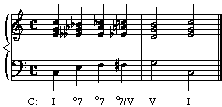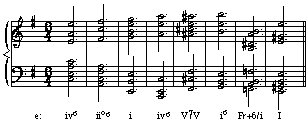
Exceptional uses of the o7, N6, and +6 Chords
Up to this point, we have encountered the most typical, "normal" use of the o7, N6, and +6 chords. Fully-diminished seventh chords may function as viio7 in a key or as secondary diminished seventh chords (o7/V and so on); they may occur in root position or any inversion. The Neapolitan sixth chord most often occurs in first inversion, functioning as a chromatic pre-dominant chord with 4 in the bass and b2, 4, and (b) 6 in the upper voices. Augmented sixth chords (It+6, Fr+6, Gr+6, and DA+6) usually function as chromatic pre-dominant chords with b6 in the bass and 1 and #4 (forming an augmented sixth above b6) and some other note in the upper voices. You've also learned that these chords may be used as pivot chords in modulations.
It's time now to cover a few "exceptional" or unusual uses of each of these chords. Bear in mind that the "normal" use of these chords is what very frequently occurs, but you need to be aware of these exceptions, too.
The exceptional fully-diminished seventh chord
As you already know, the most normal diminished seventh chord includes a root, which resolves up by half step, and three other pitches, all of which change (typically moving down by step) upon resolution of the chord. Let's call this the "normal, functional" diminished seventh chord and its resolution to some major or minor triad. There are (at the very least) two types of "exceptional, irregular" diminished seventh chords, both of which provide different functions and resolutions than the "functional" diminished seventh. These are the common tone diminished seventh and the consecutive diminished seventh. The common tone diminished seventh chord includes a note in common with the chord of resolution; it thus does not resolve in a completely "functional" manner. It is labeled CTo7 (makes sense, huh?). See the Mozart example below--the third beat of m. 3 looks like o42/iii in G major, but it obviously doesn't function that way (it resolves to I). Notice that the note G is the common note between the diminished seventh chord and the following one; therefore, the label CTo7 is the best one in this situation. (see also: C/M, pp. 627-629, The Common-Tone o7 Chord.)

The consecutive diminished seventh is even simpler: when one diminished seventh resolves directly to another one, this is an example of consecutive diminished seventh chords. The example below shows a tonic chord then three diminished seventh chords in a row. The first two are labeled o7 because they are followed by another diminished seventh chord. The final one resolves functionally; therefore, it is given its functional label of o7/V.

The exceptional Neapolitan chord
Here are a couple additional items of information about the Neapolitan chord:
- It sometimes may occur in root position, in which case it's simply labeled N (or bII). This happens more frequently in the 19th century; Chopin was fond of it.
- The Neapolitan may be preceded by its own dominant, which would then
be labeled V7/N. The progression V7/N -- N and V42/N -- N6 are the most
common. The Chopin example given below shows this:

- Given that the Neapolitan may be preceded by its own dominant, it may occur to you that the Neapolitan could even be tonicized, and this is the case. Composers sometimes wrote entire tonal regions in the Neapolitan; for example, in a piece in C major, entire sections may be in Db major (Beethoven and Schubert were especially fond of this special key relationship; note how distant the keys are).
The exceptional augmented sixth chord
Here are a couple additional items of information about augmented sixth chords:
- The +6 chords may occur in "inversion," though this is pretty
rare. Usually, the +6 interval is inverted to be a o3; thus scale degree
b6 would be in some upper voice and #4 would be in the bass. As you can
see in the example below, it isn't necessary to label the inverted +6 in
any special way. Why not? Because the +6 chords don't really have roots--they're
more about voice leading. As a result, "inversion" isn't really
possible.

- The +6 chords may occasionally be "of" something other than
V. In other words, the tremendous "pull" of an augmented sixth
may move to a goal other than V. Some theorists call these "secondary
augmented sixth chords," since they serve to linearly embellish something
other than the norm. Often the goal will be the tonic chord, in which case
the augmented sixth involved will be the interval from scale degree b2
up to 7. This type of chord is labeled +6/x, where x is some triad other
than V. See the example from Brahms's Symphony No. 4, mvt. IV:

Tritone substitution
We're now just a step away from something really cool: the use of tritone substitution. This involves the interchangability of dominant seventh chords whose roots are a tritone apart--for example a Db7 chord may substitute for a G7 chord. The roots are a tritone apart, hence the name tritone substitution. In fact, these two chords share the same tritone: a Db7 chord contains the tritone F -- Cb, while the G7 contains F -- B. Shown just using chord symbols and roman numerals, it would look like this:
Dmi7 G7 C becomes Dmi7 Db7 C ii7 V7 I ii7 Gr+6/I I
As you may be aware, this kind of harmonic technique is used all the time in jazz, though its origins are in nineteenth-century "legit" music (Liszt, Wagner, others).
Here's another example, written out:
